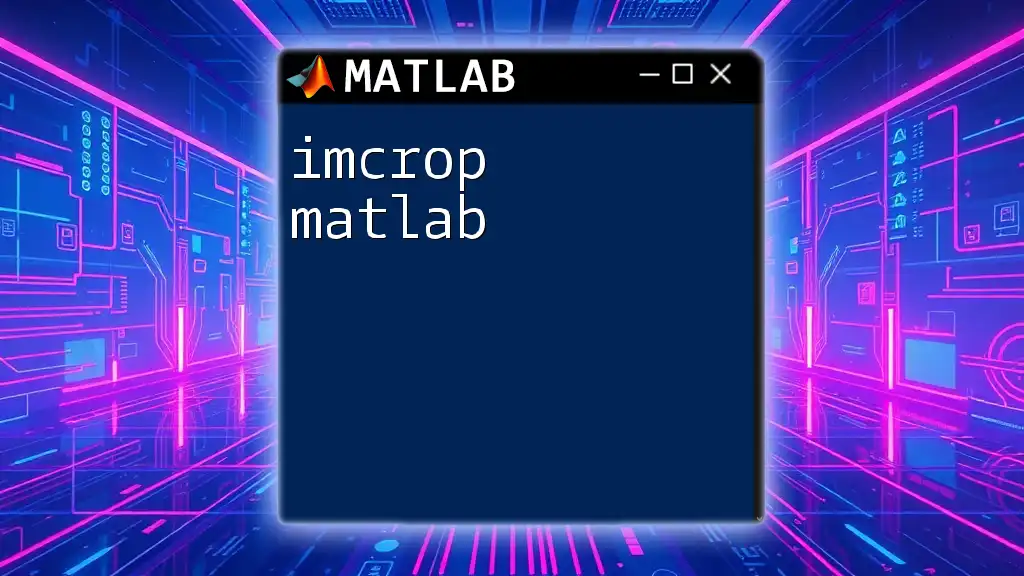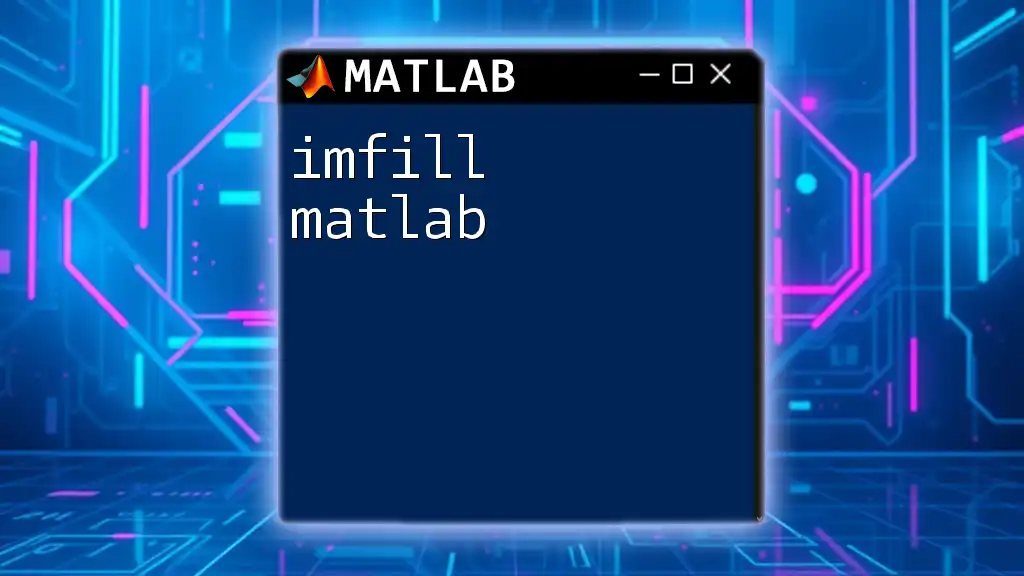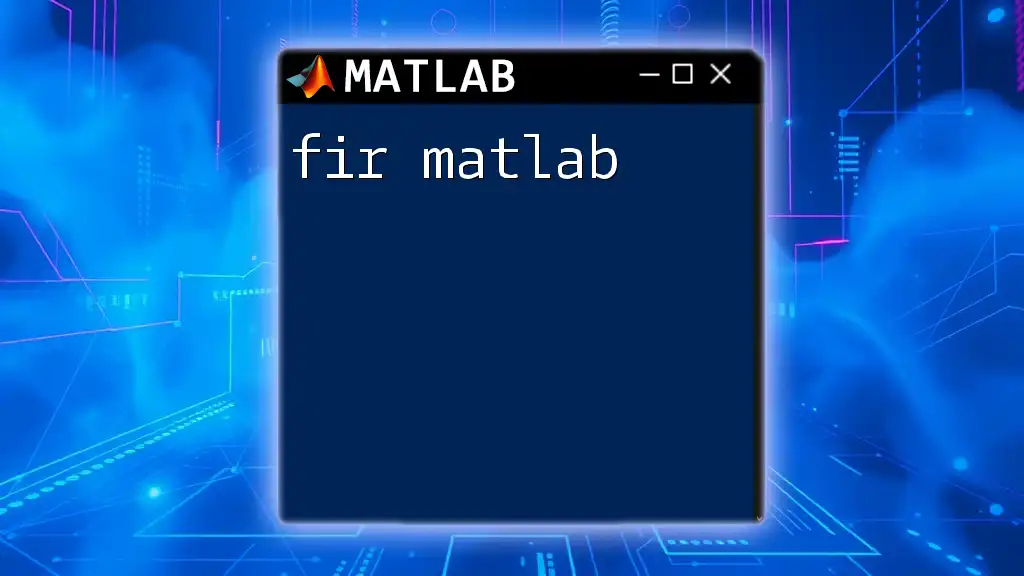The `imcrop` function in MATLAB allows users to interactively select and crop a rectangular region of an image displayed in a figure window.
% Example of using imcrop in MATLAB
img = imread('image.jpg'); % Load the image
imshow(img); % Display the image
croppedImage = imcrop; % Interactively crop the image
What is `imcrop`?
Definition
The `imcrop` function in MATLAB is a powerful tool used for cropping images. It allows users to extract a portion of an image, making it essential in the fields of image processing and computer vision. Whether you need to isolate specific features, remove borders, or prepare images for analysis, `imcrop` gets the job done efficiently.
Key Features
- Interactive Cropping Interface: Users can visually select the area they want to crop using a simple graphical interface, making it intuitive and user-friendly.
- Flexibility in Specifying Crop Area: `imcrop` allows for both rectangular and custom-defined cropping areas, adapting to various needs.
- Efficient Batch Processing: The function can be used programmatically to crop multiple images at once, making it a suitable choice for large datasets.

Getting Started with `imcrop`
Prerequisites
To effectively use `imcrop`, users should have a basic familiarity with MATLAB and ensure the Image Processing Toolbox is installed. This toolbox provides the necessary functions for advanced image manipulation, including `imcrop`.
Syntax of `imcrop`
The basic syntax of the `imcrop` function is as follows:
croppedImage = imcrop(A)
In this syntax:
- `A` represents the input image, which can be either a grayscale or color image.
- `croppedImage` is the output, which contains the pixel values of the cropped area.

How to Use `imcrop`
Cropping an Image Interactively
Using `imcrop` interactively is straightforward. You can simply run the function after displaying your image, and it will allow you to select the area you wish to crop.
Example Code Snippet:
% Read an image
A = imread('peppers.png');
imshow(A);
croppedImage = imcrop;
In this example, when you execute the code, the image will be displayed, and you can click and drag to select the area to be cropped. After making your selection, the cropped image will be stored in `croppedImage`.
Cropping an Image Programmatically
For more advanced uses, you might want to define the cropping rectangle programmatically rather than interactively. This can be achieved by providing a rectangle defined in the format `[x, y, width, height]`.
Example Code Snippet:
% Define the rectangle for cropping
rect = [50, 50, 200, 150];
croppedImage = imcrop(A, rect);
In this snippet, the rectangle starts at the coordinates (50, 50) with a width of 200 pixels and a height of 150 pixels. The resulting image will contain just that specified area.

Understanding the Cropping Rectangle
Defining Crop Areas
The rectangle format used in `imcrop` is crucial for effective cropping. The input to the `imcrop` function can be thought of as specifying:
- The x-coordinate and y-coordinate of the upper-left corner of the cropping area.
- The width and height of the crop box, which define the size of the rectangle you want to extract.
Visualizing Crop Areas
A useful practice is to visualize the area you plan to crop before actually executing the crop operation. This helps ensure you're selecting the correct region.
Example Code Snippet for visual feedback:
% Display the image with the defined rectangle
figure, imshow(A);
rectangle('Position', rect, 'EdgeColor', 'r', 'LineWidth', 2);
In this example, the rectangle will be drawn over the displayed image in red, allowing you to see exactly which area will be cropped.

Common Use Cases for `imcrop`
Image Editing
`imcrop` is frequently used in image editing tasks. For example, if you have an image with unnecessary borders, cropping can help enhance the visual focus on the subject.
Preparing Data for Analysis
Before analyzing images, it’s often essential to crop them to isolate areas of interest. This is particularly important in fields like medical imaging, where specific anatomical features may need to be highlighted for further study.
Creating Image Datasets for Machine Learning
In the context of machine learning, cropping can be a critical step in preparing image datasets. For tasks involving object recognition or classification, it may be necessary to crop multiple images programmatically to focus only on relevant features.
Example Workflow:
% Looping through multiple images
imageFiles = dir('images/*.png');
for k = 1:length(imageFiles)
A = imread(fullfile('images', imageFiles(k).name));
croppedImage = imcrop(A, [50, 50, 200, 150]);
imwrite(croppedImage, fullfile('cropped', imageFiles(k).name));
end
In this workflow, we read a series of images, crop them, and save the results, optimizing the process for efficiency, especially when dealing with large datasets.

Troubleshooting Common Issues
Cropping Outside Image Bounds
One common issue that users may face is attempting to crop an area that extends outside the boundaries of the image. This can lead to errors or unexpected results. Always ensure your specified rectangle lies within the dimensions of the original image.
Performance Considerations
When dealing with large images or datasets, performance can become an issue. Optimizing your code and avoiding unnecessary calculations can significantly speed up the cropping process. When cropping multiple images, using loops efficiently, as shown earlier, is key to maintaining performance.

Conclusion
The `imcrop` function in MATLAB is an invaluable tool for anyone involved in image processing. Its interactive and programmatic capabilities allow for flexibility and efficiency, whether for simple edits or complex analyses. By understanding the functionality of `imcrop` and how to effectively use it, you can greatly enhance your image manipulation skills.
Experimenting with different cropping techniques will not only improve your proficiency in MATLAB but also deepen your understanding of image analysis. Keep exploring and make sure to subscribe for more MATLAB tips and tutorials!

Additional Resources
Documentation References
For further learning, refer to the official MATLAB documentation on `imcrop`, which provides extensive insights into its various functionalities.
Recommended Tutorials
Explore additional tutorials focused on image processing and manipulation to deepen your knowledge and become adept in using MATLAB for sophisticated image analysis tasks.

















